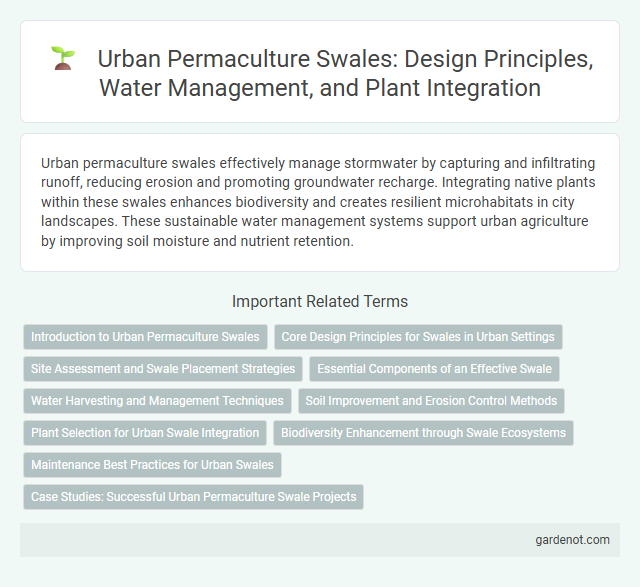Urban permaculture swales effectively manage stormwater by capturing and infiltrating runoff, reducing erosion and promoting groundwater recharge. Integrating native plants within these swales enhances biodiversity and creates resilient microhabitats in city landscapes. These sustainable water management systems support urban agriculture by improving soil moisture and nutrient retention.
Introduction to Urban Permaculture Swales
Urban permaculture swales are designed landscape features that capture and infiltrate rainwater, reducing runoff and increasing soil moisture in city environments. These shallow, vegetated trenches follow contour lines to slow water flow, promote groundwater recharge, and support drought-resistant plants. Implementing swales in urban settings enhances sustainable water management, improves soil health, and creates microhabitats for local biodiversity.
Core Design Principles for Swales in Urban Settings
Urban permaculture swales are designed based on principles that maximize water retention, reduce runoff, and support native vegetation to enhance biodiversity in city environments. Key design features include contour alignment to capture and infiltrate rainwater efficiently, soil improvement to promote microbial health, and integration with urban infrastructure to prevent erosion and flooding. Emphasizing multifunctionality, these swales serve as natural irrigation systems while providing habitat corridors and improving urban microclimates.
Site Assessment and Swale Placement Strategies
Urban permaculture swales require a thorough site assessment including slope analysis, soil type determination, and existing vegetation mapping to optimize water capture and retention. Swale placement strategies prioritize contour alignment to slow runoff, enhance infiltration, and reduce erosion in urban landscapes. Integrating microclimate factors and land use patterns ensures swales effectively support sustainable water management and urban food production.
Essential Components of an Effective Swale
An effective urban permaculture swale integrates contour alignment, keyline design, and proper trench depth to efficiently capture and infiltrate rainwater, reducing runoff and promoting groundwater recharge. Incorporating organic mulch and native vegetation along the swale enhances soil structure, nutrient cycling, and biodiversity, fostering a resilient micro-ecosystem. Proper swale grading and overflow structures ensure controlled water flow, preventing erosion and supporting sustainable urban landscape management.
Water Harvesting and Management Techniques
Urban permaculture swales optimize rainwater harvesting by capturing and infiltrating runoff along contour lines, reducing erosion and promoting groundwater recharge. These water management techniques enhance soil moisture retention in urban landscapes, supporting healthy plant growth and reducing reliance on external water sources. Implementing swales in urban settings helps mitigate flooding risks and sustainably manage stormwater, contributing to resilient, green infrastructure.
Soil Improvement and Erosion Control Methods
Urban permaculture swales enhance soil fertility by promoting natural water infiltration, which increases organic matter decomposition and microbial activity. These swales reduce erosion through contour-based trench design that slows runoff velocity and captures sediment on-site. Incorporating mulch and native vegetation within swales further stabilizes soil and supports nutrient cycling in urban landscapes.
Plant Selection for Urban Swale Integration
Selecting drought-tolerant, native plants with deep root systems enhances water absorption and soil stability in urban permaculture swales. Incorporating diverse species such as native grasses, shrubs, and perennial herbs promotes biodiversity and resilience against urban environmental stressors. Optimal plant choice supports effective stormwater management while improving habitat quality and urban ecosystem health.
Biodiversity Enhancement through Swale Ecosystems
Urban permaculture swales create diverse microhabitats that support native plants, beneficial insects, and wildlife, significantly enhancing urban biodiversity. These swale ecosystems improve soil health and water retention, fostering a resilient environment for pollinators and other vital species. Integrating swales into urban landscapes promotes ecological balance and sustains green infrastructure essential for thriving urban biodiversity.
Maintenance Best Practices for Urban Swales
Urban permaculture swale maintenance requires regular inspection to prevent sediment buildup and ensure efficient water infiltration. Removing debris and controlling invasive vegetation help maintain soil permeability and support native plant growth. Periodic mulching and recontouring improve swale function, promoting stormwater management and reducing urban runoff.
Case Studies: Successful Urban Permaculture Swale Projects
Urban permaculture swale projects effectively manage stormwater runoff while enhancing soil fertility and supporting urban biodiversity. Case studies in cities like Melbourne and Portland reveal significant improvements in water retention, reduced flooding, and increased urban green spaces through strategic swale design. These projects demonstrate scalable, sustainable solutions to urban water challenges by integrating permaculture principles into city landscapes.
Urban permaculture swale Infographic

 gardenot.com
gardenot.com